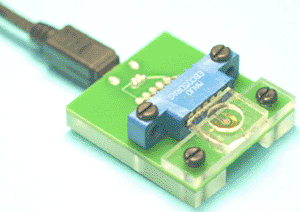Environment-Friendly Sensor Measures Manganese in Human Blood
By LabMedica International staff writers
Posted on 18 Aug 2011
A low-cost, disposable lab-on-a-chip sensor detects highly electronegative heavy metals more quickly than current technology generally available in health-care settings.Posted on 18 Aug 2011
The lab-on-a-chip is able to pinpoint consistently levels of manganese in human blood. The new sensor also exhibits high reliability over multiple days of use, with hours of continuous operation. With further developments, the chip could be converted into a self-check mechanism, such as with glucose screening for diabetics.

Image: Lab-on-a-chip sensor detects manganese in blood (Photo courtesy of University of Cincinnati).
The new sensor uses a technology called anodic stripping voltammetry that incorporates three electrodes: a working electrode, a reference electrode, and an auxiliary electrode. The sensor has potential for large-scale use in clinical, occupational, and research settings.
Detection of electronegative metals is difficult because hydrolysis, the splitting of a molecule into two parts by the addition of a water molecule, at the auxiliary electrode severely limits a sensor's ability to detect an electronegative metal.
The sensor is environmentally friendly in that its working electrode is made of the element bismuth instead of mercury, which is more commonly used to detect manganese. The device is also child-friendly, in that it requires only a drop or two of blood for testing as opposed to the five-milliliter sample now required in current test instruments.
The bismuth working electrode, along with the overall sensor design, also limits the effects of hydrolysis. The sensor uses a self-contained lab-on-a-chip design, which electrical engineering professor and team leader Ian Papautsky said can return results in about 10 minutes, instead of the usual 48 hours when samples are sent to a testing lab.
Engineers at the University of Cincinnati (OH, USA) created the sensor that quickly detects the presence and levels of manganese in humans. The disposable diagnostic tool is described in the August 2011 issue of the journal Biomedical Microdevices.
Related Links:
University of Cincinnati










 (3) (1).png)


